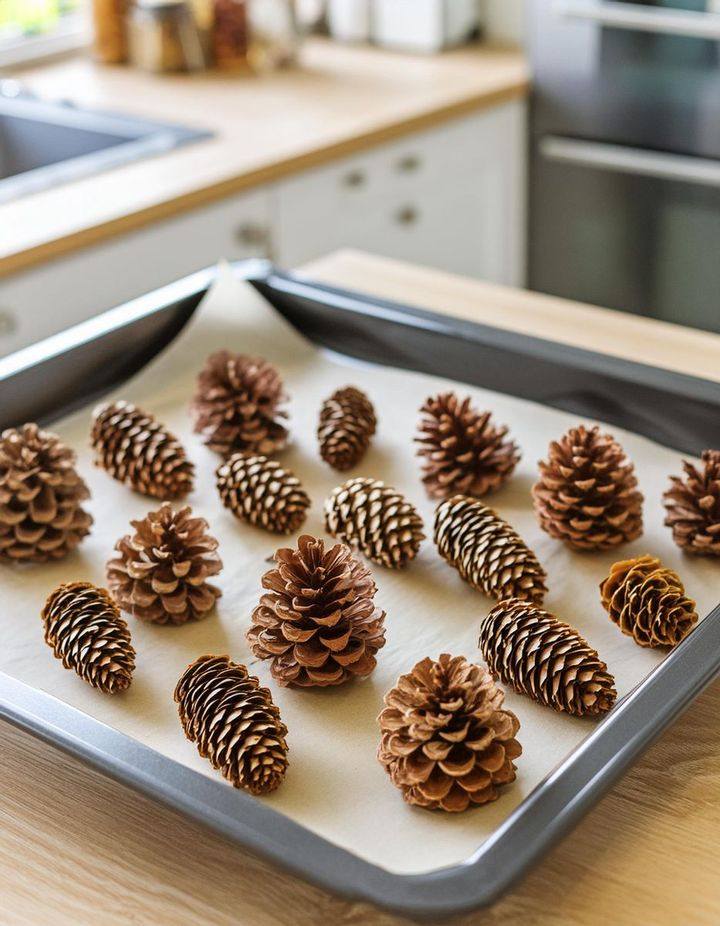ADVERTISEMENT
- Shred them: Whole pine cones take longer to decompose, so it’s best to shred them before adding them to your compost pile. You can use a garden shredder, or simply crush them with a hammer or by hand.
- Mix them well: Once shredded, mix the pine cones evenly with other compost materials such as vegetable scraps, leaves, and grass clippings. Over time, they will break down into valuable, nutrient-rich compost for your garden.
This will improve your soil structure and create a healthy, thriving garden.
3. Create a Wildlife Habitat
Pine cones are a natural habitat for small wildlife like birds, insects, and squirrels. You can use pine cones to help attract wildlife to your garden, which in turn can improve your garden’s health:
- Bird Feeders: Pine cones can be transformed into bird feeders by slathering them with peanut butter and rolling them in birdseed. Hang these homemade feeders from branches, and you’ll attract a variety of birds to your garden, helping with natural pest control.
- Insect Habitats: Many insects, such as ladybugs and certain beetles, enjoy nesting in the crevices of pine cones. Place a few pine cones in quiet corners of your garden to provide shelter for these beneficial insects, which help keep pests in check.
4. Natural Pathway Decorations and Garden Borders
Pine cones are also fantastic for decorating garden pathways and creating borders around flower beds or vegetable gardens. Simply place them along paths or around garden beds to create an organic, natural look that enhances your garden’s aesthetic appeal.
Beyond aesthetics, pine cones are durable and weather-resistant, making them an excellent option for edging and pathways that can stand up to the elements.
5. Improve Drainage with Pine Cone “Bricks”
If your garden has heavy clay soil that doesn’t drain well, you can use pine cones to help improve the drainage. Place pine cones at the bottom of planting holes, pots, or raised beds to create air pockets and improve the flow of water.
Here’s how to use them:
- Simply place a layer of pine cones at the bottom of your planting area before adding your soil.
- The pine cones create gaps that allow excess water to drain more easily, reducing the likelihood of waterlogged soil and root rot.
You can also use pine cones in raised garden beds or in containers to help create better drainage for plants that don’t like soggy soil.
6. Erosion Control
If you have a hillside garden or areas prone to erosion, pine cones can act as a natural barrier to help control soil erosion. When spread over the soil, they act as a protective layer that prevents the soil from washing away during heavy rain.
Their weight and shape help them stay in place, making them ideal for helping to keep soil intact on sloped or uneven terrain. They also promote the growth of vegetation in these areas, further preventing erosion in the long run.
7. Pine Cone Craft Projects for the Garden
If you’re into DIY projects, pine cones can be repurposed into charming garden crafts. From creating natural flower pots to using them in wreaths, there are countless ways to incorporate pine cones into your garden decor. You can:
- Make a pine cone birdbath stand: Use pine cones to create a rustic stand for a small birdbath in your garden.
- Create a pine cone wreath: Hang it in a tree for a seasonal decoration.
- Use pine cones in fairy gardens: Use small pine cones to create miniature accessories in your whimsical garden creations.
8. Boost Soil Acidity with Pine Needles
If you have acid-loving plants like azaleas, blueberries, or rhododendrons in your garden, you can use pine cones and pine needles to naturally increase the acidity of the soil. Pine needles break down to create a slightly acidic environment, which is perfect for these types of plants.
Simply scatter pine needles and pine cones around the base of your acid-loving plants to maintain a soil pH that encourages healthy growth.
How to Collect Pine Cones for Your Garden
Collecting pine cones is easy—just head outside and look for fallen cones under pine trees. Here are a few tips for gathering them:
- Choose clean, intact cones that aren’t damaged by pests or rot.
- Pick up cones after a storm: Strong winds often cause pine cones to fall in large quantities, so stormy weather can be a great time to gather.
- Store them properly: Once collected, store the pine cones in a dry place until you’re ready to use them. If you plan to use them for crafts or as mulch, it’s a good idea to bake them in the oven for about 20 minutes at a low temperature (around 200°F/90°C) to kill any insects or seeds inside.
Final Thoughts: Pine Cones are a Gardener’s Hidden Treasure
As a gardener, you’re always looking for ways to improve the health and beauty of your garden, and pine cones can be a game-changer. Whether you use them as mulch, compost material, or wildlife habitats, they provide a host of benefits that can improve your garden’s ecosystem and overall vitality. Plus, they’re completely free and readily available—just waiting for you to collect and put to work!
So, the next time you’re out for a walk in the woods or your local park, make sure to gather as many pine cones as you can. Your garden—and the environment—will thank you!
ADVERTISEMENT
